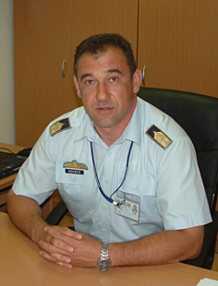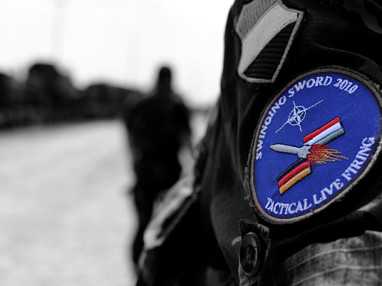The Gyõr corps’ exam in the line of fire
Szöveg: Ferenc Demeter | 2010. július 23. 8:41One of the Mistral units of the HDF 12th ‘Arrabona’ Anti-Aircraft Missile Regiment performed a tactical live fire exercise in the beginning of July at the artillery range in Todendorf, Germany. At the live fire exercise Hungarian troops annihilated six targets out of six live missile launches. We interviewed Lt.Col. (eng.) Ferenc Kovács, the commander of the regiment at the training exercise.
How much did it add to the excitement that as the commander of the regiment, this was your first real test?
The task did not came as a surprise to me, because when General Varga set the main targets for this year, told me that as deputy commander in charge of training, I would be responsible for the preparations, supervision and implementation of tactical live fire exercise Swinging Sword 2010. I was aware of the difficulties and complexity of the assignment because this was not the first tactical live fire exercise I have participated in the last ten years. I can say that I was very glad to be responsible for the preparations for the training exercise because you must know that the greatest challenge for everyone in an anti-aircraft missile corps is if he can participate in a live fire artillery exercise, if he can experience and celebrate success together with the others. But the fact that starting from early April, I also had to act as a deputy of the general, so I had two positions at the same time, put an extra load on me.
How and for how long did the troops prepare for this task?

The preparation started in the first week of May with a one-week theoretical training, which was followed by two weeks of practical preparation here in Gyõr, and finally it ended at the Újdörögd training range with a three-week target tracking practice. Then we began the preparations of the technical equipment and the personnel for the specific task, and on June 21, when we finished, we loaded the equipment on wagons. The personnel left on June 27, it was a ’forced march’ by coach they left at 4 a.m. and arrived at 8 p.m. to the training range, which is some 1,200 kilometres from Gyõr. This was the first time in the history of the regiment we were firing in this range. I would like to emphasise that compared to previous tactical live fire exercises, the preparation period was very short, for the majority of the personnel were from the battery contributed to NATO, and in the last two or three years they have already demonstrated their preparedness at various training exercises and NATO capability evaluations. Therefore during the preparations for the live fire exercise, we had to focus on the process of missile launch and the practice of safety regulations in the first place.
How long was the exercise and who inspected it?
We were in Germany for one week, from June 27 until July 3. At the exercise the day of live fire training was June 30, and July 1 was the reserve, but the NATO supervisor team started the inspection on June 29, at 8 in the morning. The evaluators performed their duties in line with the regulations of the tactical evaluation program (TACEVAL), the command staff were from Izmir and there were 22 evaluators on the team.
What did the selected team check?
Based on the NATO evaluation guide, they were checking the first two phases of the live fire exercise. The first evaluation phase was the implementation of deployment. They were evaluating how a unit draw up in battle array from a given meeting area, together with reconnaissance. In the second phase, they were checking the execution of rocket launches, in other words, how a unit carries out its protection tasks. They were monitoring the two phases and on the basis of evaluation indices for smaller areas within the phases, they added up the results and gave the final evaluation of the unit.
Do they test the troops’ theoretical knowledge during these examinations?
The committee selected by the Hungarian Defence Forces’ Joint Forces Command had already done that in the national phase. Soldiers cannot participate in live fire exercises until they have not passed the basic infantry exam at least with an average result. Following the exam, the commander gives them permission to participate in live fire exercises.

On the whole, how successful was the live fire exercise?
In the implementation phase, the unit was ordered to annihilate eighteen enemy targets and they annihilated all eighteen of them in time, six of them with live, and the rest with simulated rocket launches. On the basis of the field report of the evaluator team, the live fire exercise phase was excellent. This means that we did not act on any of our own aircraft and annihilated the enemy targets entirely. They gave the two-day activity a good evaluation. You have to know that in order to achieve a good result, the unit has to carry out nearly 100 per cent of the tasks, which is not an easy thing to do.
Then we can be satisfied with this result?
Yes. I am very satisfied with this result. We have completed one of the most productive live fire exercises with Mistral in the recent period. We have demonstrated that the weapon system is reliable and the crew also proved that they are good operators. The personnel resolved the unexpected situations very well, therefore NATO evaluators underlined that the troops did a professional job, the unit was very motivated during the exercise. As the commander of the regiment, who was there and listened to the evaluation, I am very proud of our troops’ performance and I trust that every subordinate in the organisation under my command will support my work in a similar way in the future as well. This result is important to us because it contributes to our good reputation not only in the Hungarian Defence Forces but in NATO member states as well. With this result, the regiment has demonstrated that it is capable of performing its core duties both in the country and in operational areas.